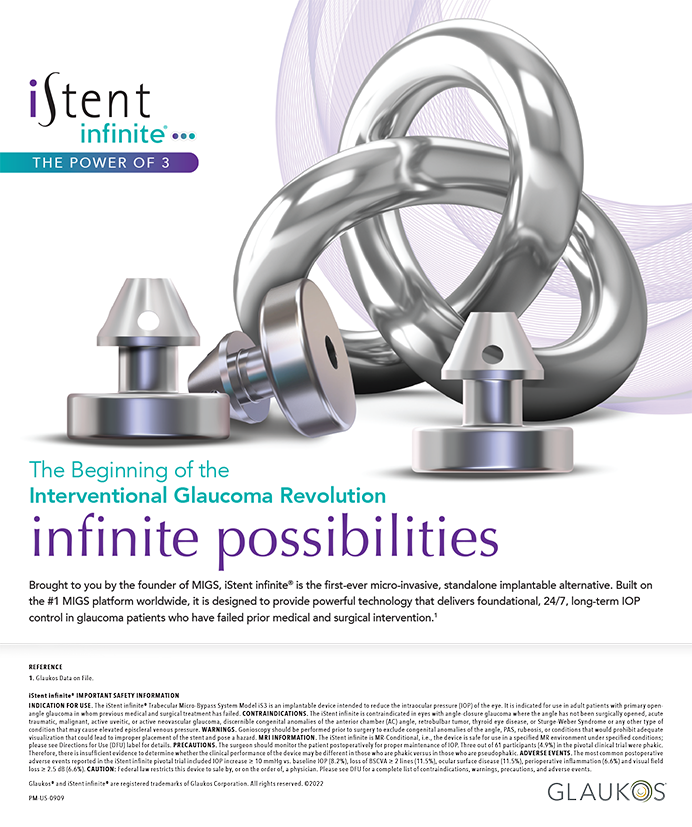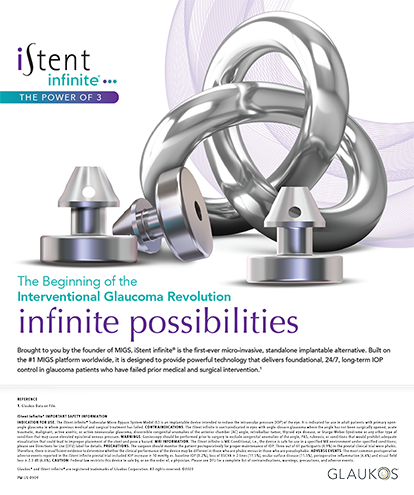A 54-year-old man rapidly develops
a dense cortical cataract after a pars
plana vitrectomy (PPV). The surgeon
uses trypan blue in a subsequent cataract
surgery to successfully create a
continuous curvilinear capsulorhexis.
A sudden shallowing of the anterior
chamber occurs during hydrodissection,
which is followed by a relative
deepening of the anterior chamber.
Hydrodissection-induced capsular
rupture is suspected with visibility
limited by a dense cortical cataract.
What subsequent steps will most likely
lead to a successful outcome?
—Case prepared by Alan N. Carlson, MD.
Steve Charles, MD
As a vitreoretinal surgeon, my comments concern both cataract surgery after a PPV and management of the posterior dislocation of lenticular material if this should occur. Some cataract surgeons believe that posterior capsular rupture is more common after PPV, whereas others disagree with this claim. Prior vitrectomy decreases the risk of retinal detachment, because the anterior movement of vitreous leading to retinal breaks is not an issue. Should posterior dislocation of lenticular material occur, the phaco probe should not be used in the vitreous cavity; the 20-gauge fragmenter is a better option. Proper visualization demands a fundus contact lens or a noncontact visualization system and an endoilluminator. I recommend using three-port, 25-gauge, sutureless PPV and making certain that a complete vitrectomy has been performed. Then, enlarge one sclerotomy to 20 gauge with a microvitreoretinal blade to insert the fragmenter. The lenticular material should be elevated away from the retina with proportional (linear) aspiration and the pedal depressed farther to apply proportional ultrasound. A careful peripheral retinal examination, preferably using contact-based, wide-angle visualization, should be done after the lenticular material is removed to find any retinal breaks, which should be treated with an endolaser and SF6 gas surface tension management (tamponade).
Bonnie An Henderson, MD
Since this patient most likely has a large linear capsular rupture, there are two options a surgeon may consider at this point: (1) convert to a larger incision for a manual extracapsular extraction, or (2) attempt to phacoemulsify the lens with abundant viscoelastic and a physical barrier present. This patient's young age and the previous PPV make the second option viable, because the lens will be soft and easily aspirated, and no vitreous will prolapse anteriorly during the removal of the lens. Because of these factors, I would attempt to phacoemulsify the lens but would have a low threshold to convert to a manual extraction.
I would use a dispersive viscoelastic to prolapse the lens out of the bag and into the anterior chamber. Next, I would place a Sheets glide under the lens to prevent posterior dislocation. It would be important to use sufficient amounts of viscoelastic anteriorly to protect the corneal endothelium and posteriorly to prevent the posterior migration of lenticular particles. Next, I would lower the bottle height and flow parameters and carefully aspirate the lens. Care must be taken to avoid breaking off small lenticular particles that might dislocate into the vitreous cavity. Frequent reinjection of viscoelastics would be important to maintain control of the anterior chamber and lenticular particles. Once the lens had been removed, I would use the vitrector with a split irrigation sleeve to remove any residual cortex. Then, I would suture to the iris a three-piece IOL with a rounded anterior edge.
Alan Kozarsky, MD
Cataract surgeons must always be aware if a vitreoretinal surgeon has preceded them into an eye. After a PPV, the cataract surgeon should not be surprised to encounter excessive anterior and posterior movement of the crystalline lens complex, incomplete zonular support, and a compromised lens capsule. In this case, the rapid development of a cataract after a PPV is almost diagnostic of an open capsule.
The positive aspects of this situation include the stained, intact anterior capsule with a continuous capsulorhexis, a soft cortical cataract, and the absence of vitreous. The initial hydrodissection possibly increased the size of the capsular opening and shallowed the anterior chamber via fluid flow into the vitreous cavity. One hopes that the deepening was not due to lenticular material forced through the capsular opening into the vitreous cavity.
The goals going forward are to maintain the integrity of the capsulorhexis and to keep the nucleus and cortex from migrating posteriorly. I recommend that the surgeon use low infusion flow to prevent the posterior displacement of lenticular material and gently remove the nucleus and cortex. When possible, the surgeon should elevate the lenticular remnants from the posterior capsule with a dispersive viscoelastic. Despite the open capsule, the residual lenticular material will not be mixed with vitreous and can be easily and safely removed. The haptics of a three-piece PCIOL can be placed in the ciliary sulcus and its optic captured in the anterior capsulorhexis.
Alan N. carlson, MD
The key and overriding principle eloquently presented by Drs. Charles, Henderson, and Kozarsky is the importance of avoiding vitreous mismanagement. Although it is important to prevent lenticular material from migrating posteriorly whenever possible, it is essential that the surgeon resist chasing this material posteriorly with the phaco handpiece. Some of the early research studying retinal detachment found that an effective way to produce a retinal detachment in an animal model involved using the phaco handpiece in this manner. This is further supported by clinical observations.1 Recognizing the complexity of some of these cases, it may also be a prudent alternative simply to contact your favorite posterior segment surgeon to safely remove the lenticular material along with vitreous while preserving residual capsule for a sulcus-supported IOL.
Section Editor Alan N. Carlson, MD, is a professor of ophthalmology and chief, corneal and refractive surgery, at Duke Eye Center in Durham, North Carolina. Dr. Carlson may be reached at (919) 684-5769; alan.carlson@duke.edu.
Section Editor Steven Dewey, MD, is in private practice with Colorado Springs Health Partners in Colorado Springs, Colorado.
Section Editor R. Bruce Wallace III, MD, is the medical director of Wallace Eye Surgery in Alexandria, Louisiana. Dr. Wallace is also a clinical professor of ophthalmology at the Louisiana State University School of Medicine and at the Tulane School of Medicine, both located in New Orleans.
Steve Charles, MD, is a clinical professor of ophthalmology at the University of Tennessee in Nashville, and he is an adjunct professor of ophthalmology at Columbia College of Physicians & Surgeons in New York. He is also an adjunct professor of ophthalmology at the Chinese University of Hong Kong. Dr. Charles may be reached at (901) 767-4499; scharles@att.net.
Bonnie An Henderson, MD, is a partner in Ophthalmic Consultants of Boston and an assistant clinical professor at Harvard Medical School in Boston. Dr. Henderson may be reached at (781) 487-2200, ext. 3321; bahenderson@eyeboston.com.
Alan Kozarsky, MD, is a cornea, cataract, and refractive surgeon at Eye Consultants of Atlanta in Georgia. Dr. Kozarsky may be reached at (404) 350-1425; akozarsky@eyeconsultants.net.
- Aaberg TM Jr, Rubsamen PE, Flynn HW Jr, et al. Giant retinal tear as a complication of attempted removal of intravitreal lens fragments during cataract surgery. Am J Ophthalmol. 1997;124(2):222-226.


